Pilates - FAQ's
- Danielle Hattingh
- Mar 7, 2017
- 4 min read
In my career as a Pilates instructor I am often confronted with the same questions, here below I answer some of the most frequently asked questions pertaining to Pilates.

What is Pilates?
Pilates is a method of exercise developed by Joseph Pilates. It is a full body workout, focusing on strength and flexibility methods of training. Pilates focuses on the muscles of the core aka the "powerhouse". These muscles are located between the pelvic bones and wrap like a corset around the mid section, front to back. When you utilise the core muscles you should aim to draw the navel in and up towards the spine which helps to engage the muscles of the core.
What is the difference between Yoga and Pilates?
As an instructor of both disciplines there are quite a few differences between these two practices. Although initially due to fluidity of movement and mind body connection they can often be misinterpreted as one in the same. Yoga focuses more on natural movement of the body, although there is also structure in a Yoga class the structure comes in a different form. In Pilates we move in a structure set called a block and these movements are set out to be performed in sets and repetitions. I personally feel Yoga is a bit more healing in the sense that there is a lot more to focus on than just exercises.
Is Pilates going to help me loose weight?
I get asked this one a lot. I always tell my clients; Pilates you will feel in your clothes, initially you aren't going to see much difference on the scale. Pilates can range from mild to quite intense depending on the instructor and the difficulty of moves, therefore it can be quite cardio intensive. Loosing weight and keeping it off relies on consistent exercise and establishing good eating habits.
How is Pilates going to benefit me?
I strongly believe Pilates is something that just clicks! Pilates aims to improve posture by conditioning the muscles and through this helps to prevent postural compensations.
Pilates benefits the body by increasing circulation, improving co-ordination, balance and posture, muscles appear toned due to muscles being conditioned. These are just a few of the benefits of Pilates.
What does a class entail?
A good pilates class should include a variety of different movements that allow for a structured flowing class. There should be a sufficient warm up, this includes breathing work to help prepare the body and to bring the mind into a more focused state. Classical Pilates follows a set list of exercises performed one after the other and can range from 12-20 different exercises. At the end of the session there should be some mild stretches included to help bring the body back to a pre workout stage. Be prepared to move slowly and to breathe a lot, remember it also takes awhile to perfect your routine so be patient with yourself if you do not get everything the first time.
How many sessions/classes do I need to attend?
Because of its mild approach to exercise, Pilates can be practiced everyday. It compliments any type of exercise routine and safe for all. I usually recommend 2-3 sessions/classes per week, especially when you are building up and learning the fundamentals. As you get more advanced you can practice Pilates daily.
What should I wear?
Anything that you are comfortable in, try to wear clothing that is form fitting but allows for movement. A pair of leggings and a strappy top is ideal Pilates attire.
Is Pilates safe to practice during pregnancy?
Yes, Pilates is a safe exercise method for anyone, just make sure your instructor has qualified or done a pre/post natal Pilates course. An instructor will make slight adjustments for your growing belly and you will enjoy all the other added benefits of Pilates during pregnancy. More on this topic later on.
Is is necessary to eat before my class?
With all exercise I recommend that you eat something beforehand, as this will give you the energy needed to sustain yourself during and after your class, just keep it light for example, a few nuts, or an apple.
The exercises seem easy to do, am I doing it right?
I often get mixed reactions after a Pilates class. Most participants will feel slight stiffness in the abdominals the next day, but not everyone is stiff after a Pilates class. This can be dependant on quite a few things for example, general awareness of the body, how much you currently exercise and the level of the class attended. However, the degree to which you are stiff the next day is not the only indicator of whether is was a good workout or not. Even if you aren't stiff the following day, doesn't mean you didn't do it right.
My final thoughts on Pilates is that you need to be consistent, attend classes and you will see the differences in your body. As you progress you will find more enjoyment in being challenged and you will also notice your ability to cope with more exercises.
What are your thoughts? Please comment below if you would like to find out more.
Yours in fitness, health and wellness

Comments